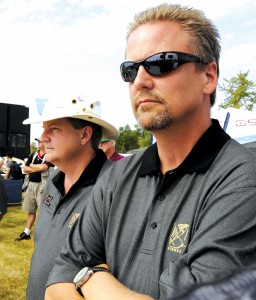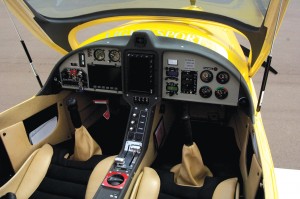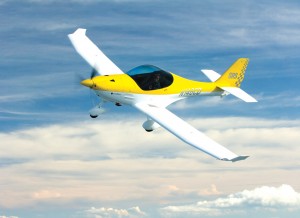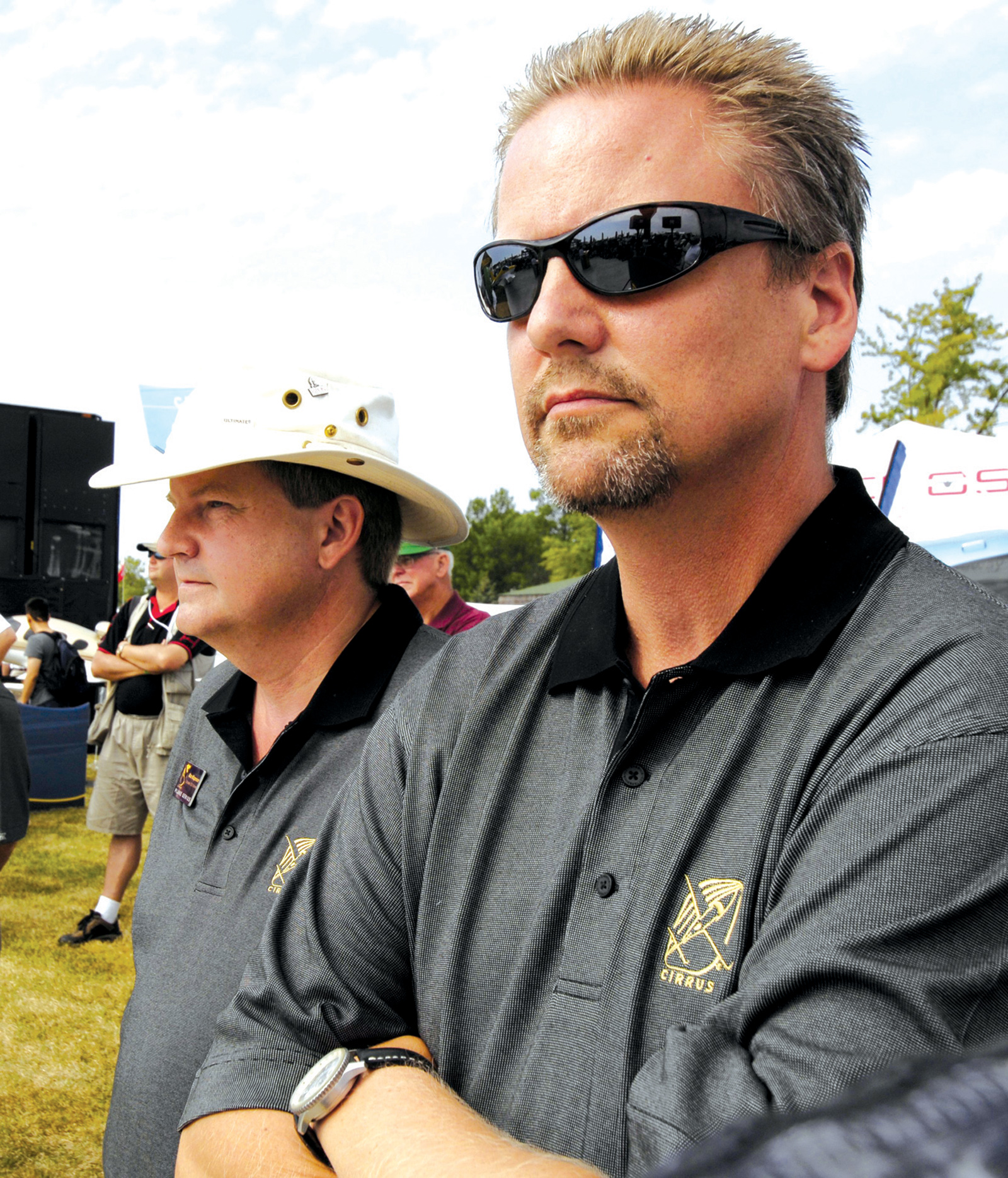
Cirrus Design Corporation cofounders Alan (left) and Dale Klapmeier take a moment to relax after the launch of the company’s new SR Sport at AirVenture 2007.
By Karen Di Piazza
Cirrus Design Corporation, a single-engine piston aircraft manufacturer, is noted for its line of fast, snazzy-looking SR20s, SR22s and recently certified SR22-G3 turbo. Alan Klapmeier, cofounder, CEO and chairman, says the company is currently trying to figure out how to “slow down” its new light sport aircraft, the SR Sport. The Duluth, Minn.-based company launched its two-seat, all-composite SRS during EAA AirVenture Oshkosh 2007.
“The SR Sport is too fast for certification in the LSA category,” Klapmeier said. “This is a first for us; we have to slow down the speed of an aircraft!”
When the company debuted the SRS, it wasn’t committed to the 100-hp Rotax 912S engine. According to Kate Dougherty, Cirrus spokesperson, the company has now made that decision.
“The SRS is efficient,” she said. “You can use regular automobile gasoline or aviation gasoline.”
Dougherty says people are excited about this “affordable, fun plane.”
“We hope to deliver our first SRS to EAA next year,” she said.
Cirrus is yet to set a firm price for the plane.
“The price is expected to be in the $100,000 range,” Dougherty said. “We’ll be competitively priced, which is one of the reasons the SRS, based on the Fk 14 Polaris, will be produced by Fk Lightplanes of Speyer, Germany. We’ve been looking at an LSA since 2003; we’re not out to reinvent the wheel. But we will add our own design flair; you’ll know the SRS is a Cirrus airplane. We’re in the process of making a final decision on the vendor for the avionics, etc. Although we’re not taking deposits yet, we’ve received more than 500 inquiries.”
Cirrus’ jet

Cirrus promises cutting-edge avionics for the cockpit of its new SR Sport, a two-seat light sport aircraft. The company hasn’t announced the vendor for the avionics.
Since Cirrus unveiled its full-scale, seven-place jet mock-up on June 28, no official name has graced the aircraft’s profile.
“We’ve been so busy with other projects, we haven’t had a chance to decide what we’re calling our jet,” Dougherty said.
Even without a name, she said the response has been great.
“To date, we have 250 position holders for our seven-place, single-engine jet,” she said.
She said Cirrus is in the process of finalizing the price of the aircraft, which is expected to cost nearly $1 million. The deposit amount is $100,000, with certification aimed for 2010.
Dougherty said the design of the aircraft’s swept-up doors and steps more than allows for easy access into the cabin—for people and pets.
“People who attended the unveiling said it was important for them to be able to bring their pets along,” she said. “Some aircraft aren’t designed to easily accommodate children or pets. People who will be flying this aircraft are in the owner-pilot crowd; they want to be able to bring the whole family, including pets.”
Dougherty said position holders described the jet as “sexy, roomy and comfortable.”
“The cabin’s interior is spacious with large windows,” she said. “Its leather seats recline and are able to slide aft or forward on a track.”
Klapmeier, a pilot who flies several Cirrus models, says although the company’s goal wasn’t to design a sexy jet, he’s not disappointed that people think it has sex appeal.
“This is a ‘personal jet’—the design is all about comfort,” he said.
Powered by a Williams International FJ33-4A-19 engine, the aircraft’s maximum operating altitude is 25,000 feet, and the avionics, yet to be announced, will be comprised of cutting-edge technology.
South Saint Paul, Minn.-based Ballistic Recovery Systems Inc. has been the sole vendor for the Cirrus Airframe Parachute System, but Dougherty says Cirrus is considering other vendors for the jet.
“BRS has been the vendor for all of our aircraft; they’ll also manufacture the CAPS for the new SRS because Fk Lightplanes already uses BRS’ parachutes,” she said. “We haven’t ruled out BRS, and we have no complaints about the company. Cirrus spent millions of dollars with BRS to develop the CAPS in the first place; Cirrus is also a shareholder of BRS. It’s a great company.”
Dougherty said the general aviation industry has more options today.

Alan Klapmeier, Cirrus CEO, says the company is trying to slow down the speed of the all-composite SR Sport.
“The GA industry has advanced its technology in all areas; parachute recovery systems are no exception,” she said. “When Cirrus first started out in 1994, we had to find a company that was capable of developing the CAPS. At that time, no one else in our industry was using this advanced, lifesaving technology; back then, we introduced advanced, all-glass cockpits, too. Today, we’re not chasing down one vendor; we have companies approaching us to manufacture the CAPS. We want to explore our options.”
She said during the National Business Aviation Association’s 60th Annual Meeting & Convention, Sept. 25 -27, in Atlanta, Ga., Cirrus won’t have its full-scale jet mock-up on display. Rather, the company will bring a smaller concept design. The full-scale jet mock-up will be on display at the Aircraft Owners and Pilots Association’s annual expo, AOPA Expo 2007, Oct. 4 -6, at the Connecticut Convention Center in Hartford, Conn.
Meanwhile, Dougherty said the reason for the company’s slight dip in aircraft deliveries for the first half of 2007 was due to enhancements made on the SR22-G3.
“For one thing, we designed a new wing—the whole system is different,” she said. “The SR22-G3 now has an option for air conditioning; orders were recently upped by 100 due to that feature. Our engineers spent more than two years designing and testing the G3. With nearly 700 changes and aircraft systems improvements, the G3 is the culmination of virtually everything Cirrus has learned about engineering and design since it first opened its hangar doors.”
For more information, visit [http://www.cirrusdesign.com].











